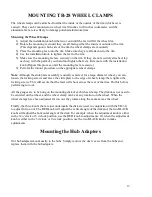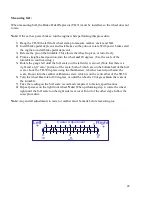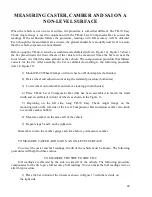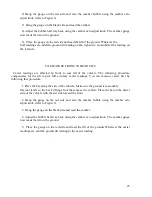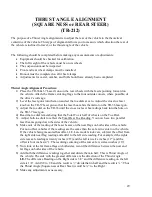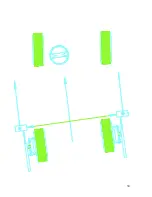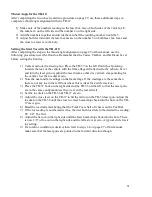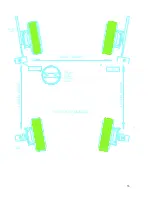
29
THRUST ANGLE ALIGNMENT
(SQUARE NESS or REAR STEER)
(TR-212)
The purpose of a Thrust Angle alignment is to adjust the rear of the vehicle to the theoretical
centerline of the vehicle. This type of alignment allows you to measure which direction the rear of
the vehicle is inclined to travel, or the thrust angle of the vehicle.
.
The following should be completed before making any measurements or adjustments:
x
Equipment should be checked for calibration
x
The full weight of the vehicle must be on its wheels
x
The suspension must be inspected
x
Front and rear wheel clamps must be installed
x
Runout must be completed on all wheel clamps
x
Adjustments for caster, camber, and SAI should have already been completed
Thrust Angle Alignment Procedure:
1)
Place the TR-36 & 37 Laser Guns on the rear wheels with the lasers pointing forward on
the vehicle. Attach the frame centering flags to the four outside corners, where possible, of
the driver’s roll cage.
2)
Level the laser guns turn them on and set the toe dials at zero. Adjust the cross toe laser
knob on the TR-37 laser gun so that the laser beam hits the mirror on the TR-36 laser gun.
3)
Adjust the toe dial on the TR-36 until the cross toe laser beam drops back into the hole on
the TR-37 laser gun.
4)
Read the toe dial remembering that the Total Toe is half of what is on the Toe Dial.
5)
Adjust both toe dials to reflect the Total Rear Toe Reading. You now have two parallel
laser beams going down the sides of the vehicle.
6)
Make note of the reading of the laser beams on the near flags on both sides of the vehicle.
For non offset vehicles if the readings are the same then the axle is in center on the vehicle.
If the vehicle being measured has offset, I.E. Late model stock cars, subtract the offset from
the right side near flag reading and add it to the left side reading. For example if the rights
side rear axle reading is twenty inches (20”) and the left is twelve inches (12”) and the
offset is four inches (4”). The resulting centering of the rear axle is sixteen inches (16”).
7)
Now look at the far frame flags on both sides, record the difference between the near and
far flags on both sides of the vehicle.
8)
Add both the difference readings together and divide them in half. This is Thrust Angle of
the vehicle. The side with the greatest difference is the direction of the Thrust Angle.
I.E.
The difference Reading on the Right side is 3/8” and the difference reading on the left
side is 1/8”. Add 3/8 to 1/8 and the result is ½” divide that in half and the result is ¼”. Thus
the Thrust Angle (Square ness or Rear Steer) would be ¼” to the Right.
9)
Make any adjustments as necessary.



